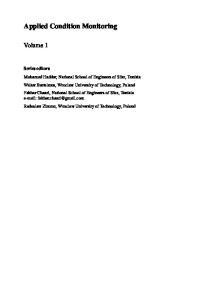Micromechanical modeling of fatigue crack initiation in polycrystals
- PDF / 1,046,511 Bytes
- 12 Pages / 584.957 x 782.986 pts Page_size
- 72 Downloads / 374 Views
Fatigue is an important mechanism for the failure of components in many engineering applications and a significant proportion of the fatigue life is spent in the crack initiation phase. Although a large number of research work addresses fatigue life and fatigue crack growth, the problem of modeling crack initiation remains a major challenge in the scientific and engineering community. In the present work, a micromechanical model is developed and applied to study fatigue crack initiation. In particular, the effect of different hardening mechanisms on fatigue crack initiation is investigated. To accomplish this, a model describing the evolution of the particular dislocation structures observed under cyclic plastic deformation is implemented and applied on randomly generated representative microstructures to investigate fatigue crack initiation. Finally, a method is presented to calculate the S–N curve for the polycrystalline materials. With this work, it is demonstrated how the micromechanical modeling can support the understanding of damage and failure mechanisms occurring during fatigue.
I. INTRODUCTION
Fatigue is the process of progressive damage accumulation in engineering components subjected to repeated cyclic loading. Due to cyclic loading, permanent microstructural and topological changes take place which are caused by repeated, partially irreversible cyclic microstrains. The accumulation of these microstrains over the increasing number of cycles ultimately leads to fatigue damage.1 Due to prior limitations in testing capabilities (frequency and required test time) the fatigue limit was traditionally attributed to a stress amplitude that a component would withstand over 106 or 107 fatigue cycles. In ductile materials, cracks initiate along slip bands1 in a grain, or at grain boundaries on the surface. Crack growth is often blocked at the grain boundaries such that propagation rates of short cracks vary between rather high and very low values.2 Because of this complex behavior, linear elastic fracture mechanics is of only limited usefulness for small cracks.3 Christ and Mughrabi4 investigated the microstructural aspects of the influence of variable amplitude loading on the cyclic stress–strain response on the basis of a comparison of the behavior in constant-amplitude tests and in a modified incremental step test (IST). Their investigations take into account the dislocation slip behavior and particle strengthening. It is known5 that fatigue cracks can form below the fatigue limit. For certain alloys, the crack can be arrested under constant amplitude loading. For other alloys, an
Contributing Editor: Mathias Göken a) Address all correspondence to this author. e-mail: [email protected] DOI: 10.1557/jmr.2017.384
arrest limit is not observed under successively reduced amplitudes of loading in high cycle fatigue (HCF) and even in very high cycle fatigue (VHCF) regimes. This can, however, result in failure mode transitions from surface to subsurface crack initiation.6 Furthermore, the applicability of physically
Data Loading...











